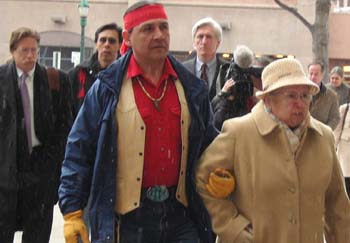The Indian wars continue in the Americas, and once in awhile we win! As conflicts over indigenous lands and resources escalate in Central and South America, the protection of indigenous peoples' rights to self-determination and control over their land is more important than ever.
Since the adoption of the United Nations Declaration on the Rights of Indigenous Peoples, we are seeing more progress in the recognition of indigenous land rights. Two recent victories in Brazil and Nicaragua set important precedents for indigenous peoples.
 Armstrong Wiggins with Davi Yanomami and his family in Brazil. The Center, in groundbreaking work for Indian land rights, brought the first indigenous rights case to the Inter-American Commission for protection of Yanomami lands. ILRC photo |
BRAZIL
In early December, after a 20-year battle, Brazil's Supreme Court ruled in favor of creating the four million-acre Raposa Serra do Sol reserve in northern Brazil near the Venezuela border, one of the largest protected indigenous areas in the world. Read the story: Ruling Puts Brazil Closer to Creating a Large Indigenous Reserve
NICARAGUA
On December 15, 2008, Nicaragua's Attorney General and other officials traveled to Awas Tingni to formally hand over title for some 73,000 hectares of their traditional homelands. It had been a long struggle and the community was very thankful to secure their land rights.
Awas Tingni v. Nicaragua became a landmark case decided by the Inter-American Court of Human Rights in which an international tribunal with legally binding authority found a government in violation of the collective land rights of an indigenous group. This set an important precedent for the rights of indigenous peoples in international law.
The Awas Tingni case was filed by the Indian Law Resource Center in 1996 under the guidance of Armstrong Wiggins, a Miskito Indian leader from Nicaragua, who now is Director of our Washington, D.C. office and who oversees our Central and South American work.
 The Center's team took the case of the Awas Tigni to the Inter-American Court. ILRC Photo |
Lead counsel for the Center on the case was Jim Anaya, now a law professor at the University of Arizona who was recently appointed Special Rapporteur on the United Nations Declaration on the Rights of Indigenous Peoples. Professor Anaya continues to oversee work to implement the Court's judgment.
For more on the Awas Tingni case, click here.
ONONDAGA
A recent article in Orion Magazine gives a moving account of the Onondaga Nation's recent land rights action seeking title for the purpose of ecological restoration of their homelands.
 Onondaga leaders Jake Edwards and Dorothy Webster and attorneys go to court. John Berry, Syracuse Post-Standard photo. |
For over 20 years, the Center has been part of the legal team representing the Nation. In 2005, the Nation filed an historic lawsuit against the State of New York and others for stealing Nation lands in violation of federal laws. We gave oral arguments on the case before a federal district court in October of 2007. We still await the court's decision, but expect to hear any day now.
Learn more about the Center's case on behalf of the Onondaga Nation on our website.